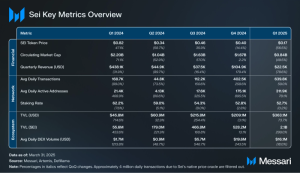Download the PDF version of this report by clicking here.
Key Insights
- Network usage was consistent quarter over quarter with 436,000 users and 878 million DOT transferred.
- A total of 20 parachains have won slots bonding 131 million DOT (11% of the total supply; worth $919 million) for the two-year lease period.
- Staking activity was consistent with a range of 54% to 56% of total DOT staked. Additionally, validators are evenly distributed with 95% of validators having 1.8–2.6 million DOT staked.
- The Polkadot Treasury spent 240,000 DOT ($1.7 million) across nine transactions.
- Developer activity remains consistent with an average of 11,000 developer activity events per month.
- The Cross-Consensus Message Format (XCM) was released.
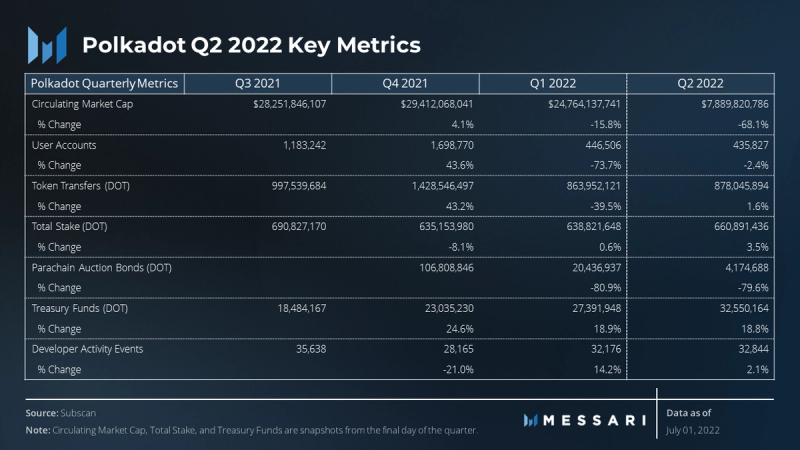
A Primer on Polkadot
Polkadot is a Nominated Proof-of-Stake (NPoS) blockchain network designed to support various interconnected, application-specific Layer-1 chains known as parachains. Each chain built within Polkadot uses Parity Technologies’ blockchain development framework Substrate, which allows developers to select specific components that best suit their application-specific chain. Polkadot refers to the entire ecosystem of parachains that plug into a single base platform known as the Relay Chain. This base platform does not support application functionality but instead houses all validators and is responsible for securing, governing, and connecting the parachains.
Performance Analysis
Network Financials

Along with the broader market, Polkadot saw its valuation decimated primarily due to macroeconomic turbulence. Polkadot closed Q2 2022 valued at $7.9 billion, down $15 billion (66%) from the start of the quarter and $49 billion (86%) from the all-time-high on Nov. 5, 2021.
Despite the bleeding valuation, Polkadot has overcome similar declines before. On Jul. 21, 2021, Polkadot reached an $11 billion market cap before gaining 406% over the following 107 days to make an all-time-high of $56.6 billion on Nov. 5, 2021.
Network Usage
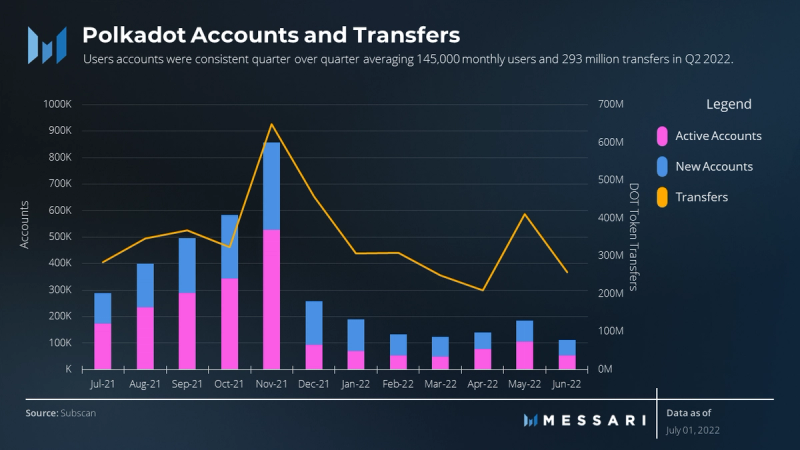
User accounts were consistent quarter over quarter. In Q2 2022, Polkadot averaged 145,000 monthly users (77,000 active and 68,000 new) compared to 149,000 monthly users (56,000 active and 92,000 new) in Q1 2022. Users peaked in Q4 2021, driven by the inaugural parachain auctions, with 566,000 average total monthly users (321,000 active and 245,000 new).
Similarly, DOT token transfers were nearly identical quarter over quarter. In Q2 2022, Polkadot averaged 293 million DOT transfers per month compared to 288 million in Q1 2022.

Polkadot uses an inflationary token model meaning there is no maximum number of DOT. Inflation rewards are distributed to validators for securing the Polkadot network, with the remainder going to the treasury. The inflation rate varies in relation to Polkadot’s ideal staking rate, but averages approximately 10% annually. During Q2 2022, Polkadot maintained a consistent staking rate with a range of 54% to 56% of total DOT tokens staked. Additionally, Polkadot ended the quarter with a total supply of 1.2 billion DOT, equating to a 2.4% quarterly inflation rate.
Decentralization and Staking
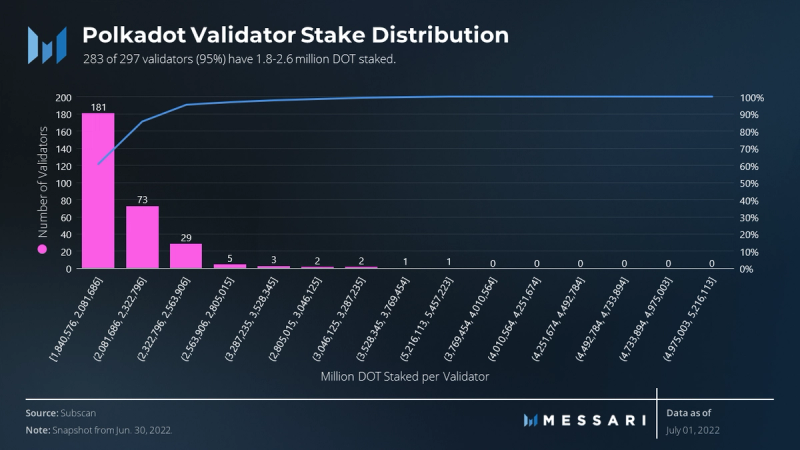
Polkadot uses a Nominated Proof-of-Stake (NPoS) consensus mechanism. Nominated PoS consensus differs from Delegated Proof-of-Stake (DPoS) consensus because nominators, i.e., DOT owners who stake their tokens with a validator, are subject to slashing.
Validators are paid every 24 hours for completing payable actions, known as era points. Every 4 hours, a subset of validators are randomly assigned to validate all parachains with a multiplier on the era points earned. The combination of era points and random parachain validation results in a probabilistic guarantee that validators earn nearly identical rewards. Because validators earn near equal rewards and distribute these rewards pro-rata to their nominators, nominators are incentivized to stake with lower-staked validators to earn higher rewards. The validator-nominator reward model is designed to decentralize Polkadot’s validator set. At Q2 2022 close, 283 of 297 (95%) validators had 1.8–2.6 million DOT staked, confirming the nominator staking game theory is working.

Because of the even rewards distribution, running multiple validators nets a greater expected value. As a result, Polkadot validators self-bond the minimum of one DOT and nominate their DOT across a maximum of 16 validators to maximize the expected value of their staking rewards. Of the total DOT staked, 99.8% is from nominators, and 0.2% is from validators self-staking.

It is possible for a single entity to run multiple validators. In Q2 2022, seven entities were running multiple validators, accounting for 22% of the total DOT staked. Additional entities could be running multiple validators, but Subscan has not identified them.
Parachains
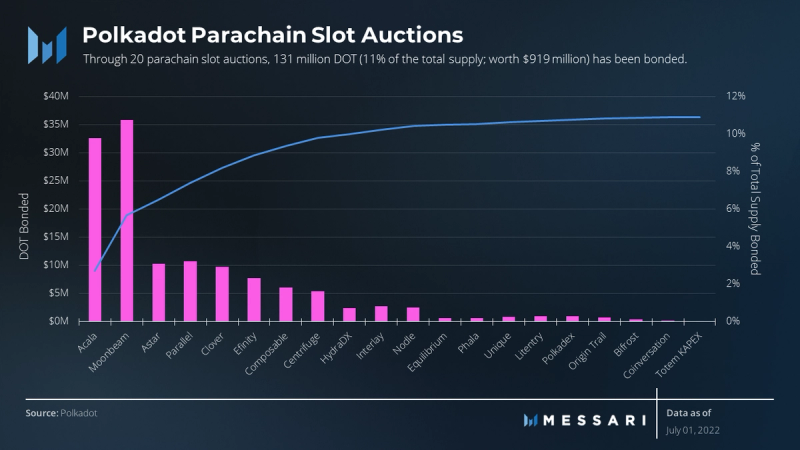
During Q2 2022, seven parachains won parachain slots, bringing the total to 20 parachains. Collectively, 131 million DOT (11% of the total supply; worth $919 million) has been bonded for the two-year lease period. Unsurprisingly, auctions 1–10 saw significantly more traction compared to auctions 11-20 with 16 times more DOT bonded. On the plus side, participants in the latest auctions receive a larger percentage of a project’s slot auction token allocation due to fewer DOT being bonded. Polkadot has 21 new auctions scheduled through February 2023 (bringing the total to 41).
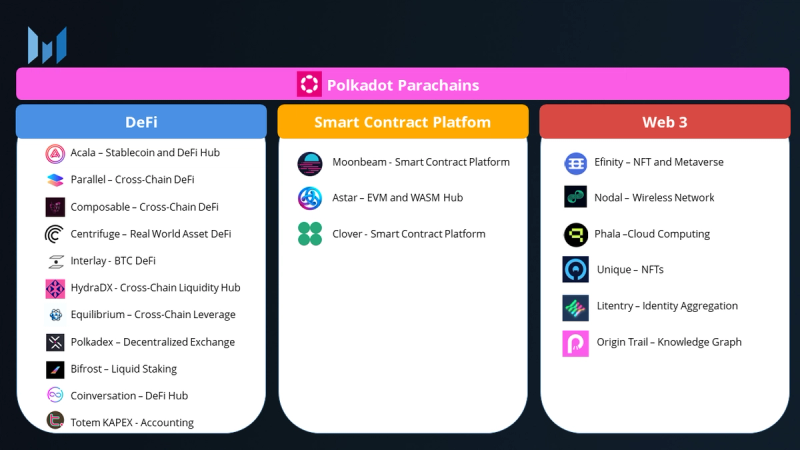
Of the first 20 parachains, 11 are DeFi chains, 3 are smart contract platforms, and 6 are Web3 infrastructure chains. For a deeper look into the parachain ecosystem, check out the Polkadot Ecosystem Overview.
Polkadot and Kusama

Another unique component of the Polkadot ecosystem is the canary network Kusama. Kusama is a sovereign blockchain with a nearly identical codebase and architecture as Polkadot; however, Kusama cycles are 4 times faster than Polkadots. All new code rollouts are proposed, approved, tested, and implemented on Kusama before moving to Polkadot. As such, Polkadot and Kusama are closely related. Over the last four quarters, the market caps of both networks have closely tracked each other with a 0.92 correlation coefficient.
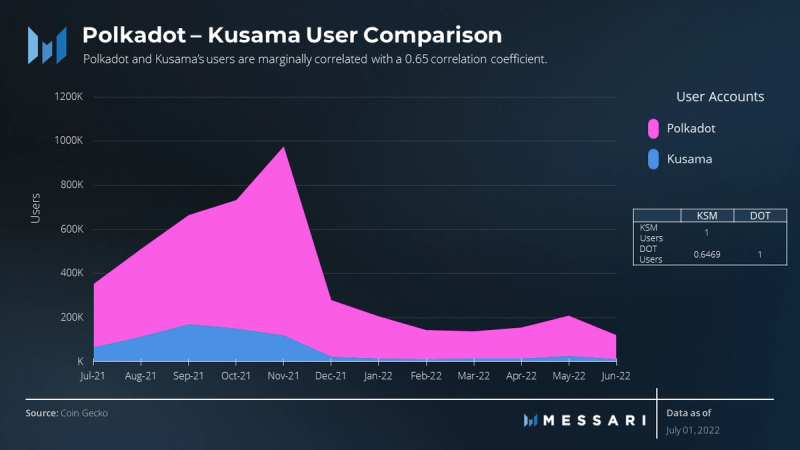
Conversely, users between Polkadot and Kusama are marginally correlated with a 0.65 correlation coefficient. In Q2 2022, Polkadot had 8.4 times more users than Kusama (436,000 versus 52,000).
Treasury
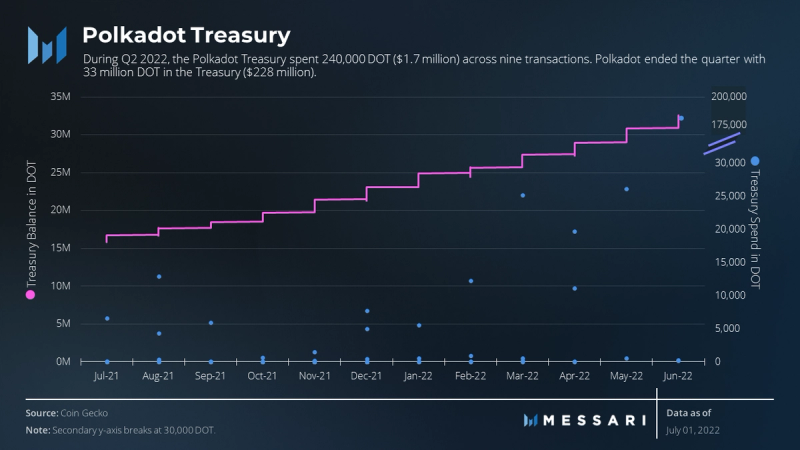
The Polkadot Treasury is funded from validator slashing, transaction fees, staking inefficiencies, and parathreads. Treasury funds are designed to be spent every 24 days, known as the spend period, and 1% of excess funds not spent are burned. During Q2 2022, the Polkadot Treasury spent 240,000 DOT ($1.7 million) across nine transactions. Of the total Treasury spend, 182,000 DOT ($1.3 million; 76%) came from a Jun. 12, 2022, spend for Polkadot at Davos during the World Economic Forum’s annual meeting, the largest Treasury spend over the last year. Polkadot closed the quarter with 33 million DOT in the Treasury ($228 million).
Developer Activity
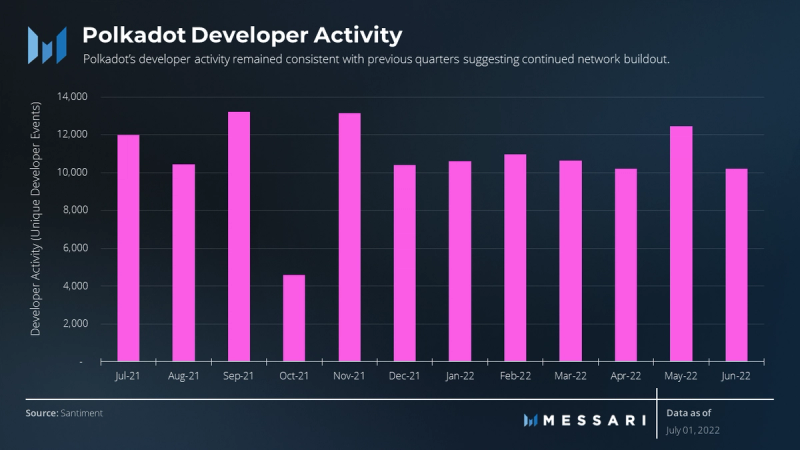
Polkadot had the second largest developer community in 2021, according to the annual Electric Capital Developer Report. Through the first half of 2022, developer activity has remained consistent with an average of 11,000 developer activity events per month. Overall, Polkadot’s developer activity remains among the strongest in crypto.
Qualitative Analysis
Governance
Polkadot combines a multi-pronged governance system with autonomous enactment to upgrade the network without hard forks. During Q2 2022, Polkadot users voted on, passed, and enacted 12 referenda:
- April 5, 2022 –Referendum 57: Runtime Upgrade to v9180
- April 6, 2022 –Referendum 56: Help Composable Finance Unbrick Their Chain
- April 10, 2022 –Referendum 58: Statemint Runtime Upgrade to v800
- May 4, 2022 –Referendum 60: Relay Chain v9190 and Statemint v900
- May 6, 2022 –Referendum 59: Unbrick Phala Network Parachain
- May 6, 2022 –Referendum 61: Lower HRMP Channel Deposits to 10 DOT
- May 25, 2022 –Referendum 63: Runtime Upgrade to v9200
- June 1, 2022 –Referendum 62: First Statemint HRMP Channels
- June 8, 2022 –Referendum 65: Runtime Upgrade to v9220
- June 21, 2022 –Referendum 66: Fix of Establishing HRMP Channels for Statemint
- June 26, 2022 –Referendum 67: Runtime Upgrade to v9230
- June 26, 2022 – Referendum 64: Polkadot at Davos World Economic Forum
Key Events
Despite the bear market, Parity, the Web3 Foundation, and the broader Polkadot community continue to build. Key developments in Q2 2022 include:
ink! Upgrades
The Parity team released four upgrades to ink!, the Substrate-based smart contract programming language that compiles to WebAssembly (WASM). An exhaustive list of additions, changes, and removals can be found here.
Introduction of Community Calls
Polkadot began conducting monthly community calls. The calls review updates in the Polkadot and Kusama ecosystems, allow ecosystem teams to introduce their protocols, and highlight upcoming developments. Community call recordings are uploaded to YouTube and summaries are tweeted by the official Polkadot Twitter account.
XCM Enabled
Cross-Consensus Message Format (XCM) was enabled with the passage of Referendum 60. XCM is a communication language allowing parachains to exchange messages with other parachains, similar to Inter-Blockchain Communication (IBC) on Cosmos. Parachains began opening bi-directional Horizontal Relay-routed Message Passing (HRMP) channels with other parachains to begin communicating with each other.
Additionally, Polkadot released a book Polkadot for Beginners: A non-technical guide to decentralization, blockchains & Polkadot. The largest Polkadot conference of the year Polkadot Decoded was held on June 29-30, the first North America Polkadot hackathon kicked off, and the first Polkadot Hacker House was held in New York.
Ecosystem Challenges
During Q2 2022, activity on Polkadot was in-line with Q1 2022. Despite successfully retaining users during the market downturn, most metrics remain substantially down from all-time-highs. To re-capture all-time-highs, Polkadot must address a handful of challenges:
First, Polkadot needs a spark. Up until now, parachains have largely operated in silos; however, with the launch of XCM, it is now possible to build cross-chain primitives. Developing new functionality and use cases will showcase the power of the network and may reignite user interest and activity. Hoon Kim from Astar Network describes several potential future innovations utilizing Polkadot and XCM.
Next, Polkadot must maintain its position as a leader in developer activity. In June 2022, dYdX announced it would be building a Layer-1 chain on Cosmos. Proponents of Ethereum rollups were upset and concerned with the decision; however, Polkadot proponents are also aching because dYdX chose to build on Cosmos over Polkadot.
Lastly, Polkadot must continue scaling XCM. At the close of Q2 2022, 16 parachain to parachain channels have been opened via a stop-gap solution HRMP. Polkadot must continue onboarding parachains and connecting them with XCM.
Roadmap
The launch of Polkadot began in May 2020 with the Relay Chain genesis block and finished in December 2021 with the launch of parachains. Several post-launch developments and optimizations have been implemented in H1 2022, with arguably none more important than the buildout of XCM. In H2 2022, the focus will be scaling XCM and parachain communication channels.
Another area of focus is the launch of parathreads. Parathreads are pay-as-you-go parachains. Instead of always being connected to the Relay Chain like parachains, parathreads pay for the Relay Chain’s security and interoperability as needed. Parathreads are useful for projects that do not wish to acquire a full parachain slot and/or existing parachains that no longer require a dedicated parachain slot.
The rollout of Polkadot Governance V2. Governance V2 will decentralize Polkadot’s governance model by removing the Polkadot Council and Technical Committee, increasing the number of proposals that can be voted on at once, and decreasing the proposal submission threshold. During Polkadot Decoded, Gavin Wood announced Kusama would begin testing Governance V2 soon.
Closing Summary
Despite a brutal macro-environment, Polkadot’s on-chain activity was consistent quarter over quarter. During Q2 2022, Polkadot had roughly 435,000 users, 878 million DOT tokens transferred, and a consistent staking rate of 54% to 56% of total DOT tokens staked. Concurrently, foundational KPIs held steady with a healthy validator distribution by total stake, strong developer activity, and seven additional parachains onboarded.
Arguably the most significant development during the quarter was the release of XCM. With XCM live, parachains began opening communication channels with other parachains. Additionally, Polkadot addressed some of the challenges highlighted in the Polkadot Q1 2022 report with the introduction of a monthly community call and newsletter, Polkadot 101 book, and ever-improving alternative wallets.
Polkadot needs to motivate its user base with a win as big as Cosmos with dYdX. The spark will likely come from a parachain or a protocol built on a parachain utilizing XCM and Polkadot’s architecture to build a novel, cross-chain use case. Only 16 parachain channels have been opened utilizing a stop-gap solution, it remains the early days for parachains.
Looking to dive deeper? Subscribe to Messari Pro. Messari Pro memberships provide access to daily crypto news and insights, exclusive long-form daily research, advanced screener, charting & watchlist features, and access to curated sets of charts and metrics. Learn more at messari.io/pro
This report was commissioned by Polkadot, a member of Protocol Services. All content was produced independently by the author(s) and does not necessarily reflect the opinions of Messari, Inc. or the organization that requested the report. Paid membership in Protocol Services does not influence editorial decisions or content. Author(s) may hold cryptocurrencies named in this report. Crypto projects can commission independent research through Protocol Services. For more details or to join the program, contact ps@messari.io. This report is meant for informational purposes only. It is not meant to serve as investment advice. You should conduct your own research, and consult an independent financial, tax, or legal advisor before making any investment decisions. The past performance of any asset is not indicative of future results. Please see our terms of use for more information.

